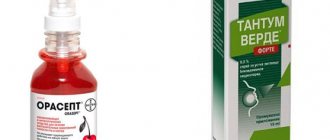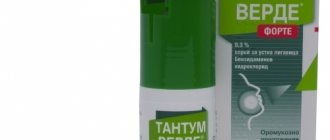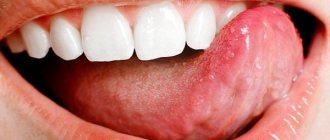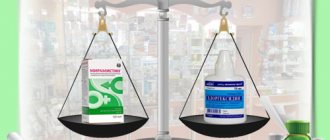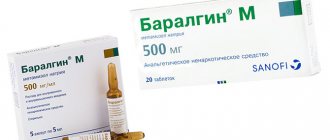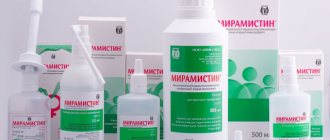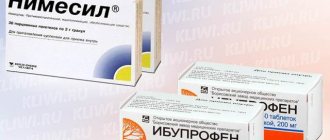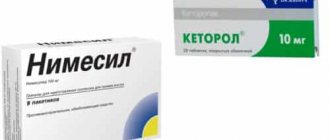Diseases of the oral cavity and nasopharynx are a common occurrence in the practice of therapists, pediatricians and some specialized specialists (otolaryngologists, dentists, infectious disease specialists). Their occurrence may be associated with airborne and sexually transmitted infections, complications of surgical operations, hypothermia and other factors.
Antiseptics, analgesics and anti-inflammatory drugs are used in the treatment of dental and otolaryngological pathologies. Miramistin and Tantum Verde have a complex effect and are often prescribed for treating the oral cavity and irrigating the throat.
Characteristics of Miramistin
The drug Miramistin, containing the active substance of the same name, affects the outer membrane of the cells of bacteria, fungi and other microbes. This leads to complete destruction of the membrane and death of the microorganism. In addition to the bactericidal effect, Miramistin stimulates tissue restoration and healing of microtraumas in the area of application, activates local immune reactions and relieves inflammation.
Miramistin is a drug that stimulates tissue restoration and healing of microtraumas in the area of application.
The antiseptic properties of the drug apply to staphylococcal and streptococcal flora (including pneumococci), Klebsiella, Escherichia coli, pathogenic fungi, pseudomonas, STI pathogens (chlamydia, gonorrhea, trichomoniasis, syphilis) and some viruses (HIV, herpesviruses, measles virus, etc.).
The action of Miramistin is manifested incl. in relation to microbial associations, hospital strains of bacteria insensitive to antibiotics, and fungi resistant to chemotherapeutic drugs.
The antiseptic interacts well with local antimycotics and antibiotics: when Miramistin is used together with drugs from these groups, their effectiveness increases.
Indications for the use of Miramistin are:
- infectious and inflammatory diseases of the respiratory tract (otitis, tonsillitis, laryngitis, acute pharyngitis, tonsillitis, etc.);
- inflammation of the gums and oral cavity (stomatitis, periodontitis, gingivitis, etc.);
- prevention of infectious complications of operations and dental procedures;
- skin treatment for tissue trophic disorders due to diabetes mellitus (diabetic foot);
- purulent inflammation of the musculoskeletal system, skin and mucous membranes;
- prevention of STIs after unprotected sexual intercourse;
- inflammation of the female reproductive system (vaginitis, endometritis), trauma and birth damage to the vagina;
- urethritis, urethroprostatitis;
- preparation of burned tissues for skin transplantation;
- treatment of fistulas, burns, wounds and other damage to the skin;
- oral hygiene, removable and non-removable dental implants.
Depending on the indications, Miramistin is prescribed in the form of a solution or ointment with a concentration of the active ingredient of 0.01% and 0.5%. A solution of the drug is used for irrigation and gargling, treatment of the oral cavity, mucous membranes and skin lesions.
When Miramistin is applied to the skin and mucous membranes, side effects may occur: a slight burning sensation that stops after 20-30 seconds, or more severe allergic reactions. A short-term burning sensation does not require cessation of therapy.
Contraindications to treatment with Miramistin are individual sensitivity to the drug and age under 3 years. There are no data on the safety of the drug during breastfeeding, so it is prescribed to lactating women with caution.
Rating of the best moisturizing sprays
Preparations with sea water and vegetable oils eliminate dry mucous membranes, which prevents the proliferation of pathogens.
The best sprays with a moisturizing effect:
- Aqualor. A popular remedy for the quick and safe treatment of oropharyngeal diseases. Contains Atlantic water, chamomile and aloe extract. The drug eliminates swelling of the mucous membranes and promotes the restoration of damaged tissues. Advantages – safe for small children, pregnant and lactating women.
- Aqua Maris. A seawater-based spray relieves inflammation and prevents the development of complications. Advantages – safety, efficiency. Disadvantages - price.
- Cameton. The spray contains camphor, eucalyptus oil and levomenthol. Combined medicine, antiseptic, removes signs of inflammation, moisturizes mucous membranes, improves sputum discharge. Advantages – convenient attachment, improvements are noticeable after 2-3 days of use, price. Disadvantages – not suitable for treating children under 5 years of age, specific taste.
- Inhalipt. A drug with the best price-quality ratio. The spray fights bacteria, relieves pain and soreness, and moisturizes the mucous membrane. Advantages - high efficiency, convenient sprayer, reasonable cost. The disadvantage is the pronounced taste of mint and eucalyptus.
- Argento-sept. A spray with an antibacterial and moisturizing effect, it relieves even severe pain and swelling of the tonsils. Advantages: safety, fast action, pleasant aftertaste. The disadvantage is the price.
Moisturizing sprays can be used for prevention during epidemics of colds.
How does Tantum Verde work?
Tantum Verde exhibits antiseptic, anti-inflammatory and mild analgesic properties. The active component of the drug is benzydamine, which is able to penetrate the cell membrane and damage important microbial structures that directly affect the rate of growth and reproduction of pathogens.
Tantum Verde is a drug with antiseptic, anti-inflammatory and moderate analgesic effects.
The analgesic effect is associated with the membrane-stabilizing and anti-inflammatory effects of the drug. It has been established that benzydamine has approximately 50% of the local anesthetic potential of tetracaine, which is used for superficial surgical interventions. The average duration of pain relief when applying the drug is 1.5 hours.
The antimicrobial effect of the drug extends to aerobic and anaerobic pathogens, incl. staphylococci, streptococci and antimycotic-resistant strains of Candida fungi, which often cause infections of the ENT organs and oral cavity.
The use of this antiseptic is indicated for the following pathologies:
- infections of the oral mucosa (gingivitis, periodontitis, glossitis, etc.);
- candidal stomatitis of the oral cavity (in combination with systemic antimycotics);
- infectious and non-infectious inflammatory processes in the ENT organs (tonsillitis, acute and indolent pharyngitis, laryngitis);
- periodontal disease;
- calculous sialadenitis (inflammation of the salivary gland).
Periodontal disease is one of the indications for the use of Tantum Verde.
The drug is also prescribed to prevent bacterial complications from operations in the oral cavity, dental procedures, injuries of the jaw and face.
The medicine is presented in 3 forms of release: a solution for rinsing the mouth and throat, tablets and an aerosol. The concentration of the active substance in the solution is 0.15%, and its dosage in 1 tablet or spray is 3 mg and 0.255 mg.
When using the medicine according to the instructions, local adverse reactions may occur (dryness, numbness of the oral cavity, burning at the site of application).
The appearance of a rash indicates the development of an allergy and the need to change the drug.
For patients with a tendency to allergic reactions and bronchial asthma, drugs with benzydamine are prescribed with caution due to the risk of broncho- and laryngospasm.
Contraindications to drug therapy are:
- allergies to substances present in the aerosol, tablets and solution (including phenylketonuria and fructose intolerance);
- children's age (up to 3 years - for aerosol, up to 6 years - for tablets, up to 12 years - for solution).
What is the difference?
An analysis of the mechanism of action of each of them will help you understand how Tantum differs from Miramistin. The drugs have different active substances, which, when they come into contact with the mucous membrane, exhibit different penetrating abilities and have different effects on microbes. The active ingredient of Miramistin is ammonium chloride monohydrate, which has a superficial antiseptic effect, that is, the ability to inhibit the vital activity and spread of pathogenic organisms at the site of its application.
Tantum (instructions) contains a substance with an antimicrobial, anti-inflammatory effect - benzydamine hydrochloride. Unlike Miramistin, this active component, due to its pronounced adhesion, can penetrate through the mucous membrane into inflamed tissues and also have an analgesic effect. Both Tantum Verde and Miramistin have the ability to destroy both bacteria and some types of fungi, the difference being the presence of an antiviral effect in the latter. For this reason, the range of use of Miramistin is wider and includes herpetic lesions, as well as complications associated with HIV.
Tantum Verde is available in the following dosage forms:
- gargling solution;
- spray with dosing pump;
- lozenges.
Spray "Tantum Verde" 0.255 mg/dose
In addition to the spray with a standard dosage of 0.15 g of active substance per 100 g of solution, there is the “Forte” option - a drug with double the concentration of the active substance (0.30 g). Due to the high concentration of benzydamine, it is possible to reduce the frequency of use, while the analgesic effect is more durable and manifests itself in a short time.
Miramistin exists in two forms - a solution with a concentration of 0.01% (instructions) and an ointment. The solution can be used both as a spray (in containers of 100, 150, 200 ml with a dispenser for irrigation) and for rinsing (bottles of 500 ml). In addition to use in the oral cavity, the drug is used for antiseptic treatment:
- areas of burns and injuries;
- bedsores and diaper rash;
- areas affected by sexually transmitted diseases (including for post-prophylaxis);
- trophic ulcers;
- postoperative wounds.
Solution 0.01% (50 ml)
Due to its superficial local effect (the active substance is not absorbed), Miramistin can be used during pregnancy and lactation. The active substance of Tantum is found in the blood after use. Its amount is too small to develop a systemic effect, but use during pregnancy and lactation is not recommended. Thus, you can determine which is better - Tantum Verde or Miramistin, based on the presence of individual contraindications and the cause of the disease (bacteria, virus).
Comparison of Miramistin and Tantum Verde
Despite a number of similar indications for use, these drugs are not analogues and do not have common components in their composition. For bacterial infections of the pharynx and oral cavity, the combined use of both drugs may be prescribed.
Similarities
In addition to the indications for use, the drugs are similar in the specifics of their effects (the presence of an antiseptic effect), side effects (in both cases, a burning sensation in the mucous membrane is possible after use) and safety for vulnerable groups of patients (both drugs are allowed to be used during pregnancy and childhood).
What is the difference
The difference between the two means is observed in the following aspects:
- mechanism of action;
- release form of the drug;
- range of applications in various fields of medicine.
Which is cheaper?
The price of Miramistin (150 ml bottle of solution) starts from 385 rubles. The cost of Tantum Verde starts from 229 rubles (for aerosol), 278 rubles (for solution) or 234 rubles (for tablets).
Taking into account the recommended duration of treatment and therapeutic dose of drugs, Miramistin is a more expensive drug.
Description of Miramistin
Miramistin is usually prescribed to treat wounds that are infected. But there are still cases when this local antiseptic solution may be prescribed for gargling. Gargling with miramistin is used in the presence of chronic tonsillitis, pharyngitis, and long-lasting sore throat. Release form: transparent liquid in plastic bottles for external use only. The average cost of antiseptic in Russia is 210 rubles per package. The active ingredient has pronounced antiseptic, antifungal and antimicrobial pharmacological effects. The drug also has an antiviral effect, in particular against the simplest herpesvirus in humans. The drug does not cause adverse reactions, with the rare exception of local discomfort at the site of application.
Which is better: Miramistin or Tantum Verde
Both antiseptics have their own advantages, which determine their preferred use for various indications.
Miramistin has a wider spectrum of action and high antimicrobial activity. It is used in various fields of medicine, so it is a universal remedy for a home medicine cabinet. In addition, this drug enhances the effect of more effective antibacterial and antifungal agents. Treatment with Miramistin is recommended for bacterial infections, incl. provoked by STIs, hospital and atypical microflora.
Compared to Tantum Verde, Miramistin has a wider spectrum of action and high antimicrobial activity.
The activity of Tantum Verde as an antiseptic is lower than that of Miramistin, but it has a good anti-inflammatory and analgesic effect. The drug is prescribed for severe pain in the area of inflammation (throat, tongue, larynx, gums, etc.) and viral etiology of infection. All 3 forms of release of the product are convenient for the treatment of diseases of the throat and oral cavity.
The choice of Miramistin or Tantum Verde for treatment, as well as the decision to replace the drug, should be made by the attending physician, who takes into account the results of laboratory and instrumental studies, complaints and medical history of the patient.
For children
Both drugs are safe for patients over 3 years of age.
For children under this age, these antiseptics are prescribed according to strict indications and under the supervision of a doctor.
What to choose for children?
If a child has signs of tonsillitis, pharyngitis, or tonsillitis (redness, swelling of the throat, pain), pediatricians often prescribe Miramistin or Tantum Verde. Both medications are used to treat children from 3 years of age. In some clinical cases, as prescribed by a pediatrician, it is possible to use them up to 3 years of age with an individual dosage calculation and choice of method of application. Spraying medications using an aerosol at an early age is not recommended due to the high risk of developing bronchospasm and reactive edema. For a child from 3 to 14 years old, other forms of drugs (tablets, spray) can be used; the dosage is based on weight in strict accordance with the instructions.
To decide which is more suitable: Tantum Verde or Miramistin for a child, it is necessary to take into account the leading symptoms of the disease and existing contraindications. If the pain symptom is severe, you should choose Tantum Verde, which contains an anesthetic component in its mechanism of action. If a child has had cases of allergies or intolerance reactions to acetylsalicylic acid or other NSAIDs (Nurofen, Ibuprofen), it is recommended to choose Miramistin, since Tantum Verde, as a representative of non-steroidal anti-inflammatory drugs, can cause a similar hypersensitivity reaction. In general, Miramistin has fewer contraindications and side effects, and the effectiveness of Tantum against inflammation and infection is higher due to the ability of the active component to adhere and absorb, and therefore have a longer effect.
Can they be used together?
The antiseptic effect of both drugs leads to the death of pathogenic microorganisms of a similar spectrum - streptococcal, staphylococcal flora, bacterial monocultures and associations. For this reason, their combined use is rarely prescribed and may be advisable for unspecified (unknown) flora, only under the supervision of a physician. Self-administration of Miramistin and Tantum Verde together can lead to drying out of the mucous membrane and other unpleasant side reactions. If necessary, the therapist or pediatrician will correctly determine the required dosage of each medication for their optimal combined effect.
The use of sprays, rinsing solutions and tablets with anti-inflammatory and antiseptic effects is a method of local impact on the site of the disease. To effectively eliminate the pathological process in both the adult body and the child, a comprehensive treatment is necessary, the individual preparation of which is carried out by a doctor. The prescription of Miramistin or Tantum Verde in this case is only part of the therapy. If, when taking one of these medications on your own, the symptoms of the disease continue for more than 7 days or worsen, you should consult a specialist.
Tantum Verde is a drug produced by an Italian pharmaceutical company; its cost is approximately one and a half times higher than the price of the domestic drug Miramistin.
Patient reviews
Tatyana, 33 years old, Minsk
Miramistin is the best drug for protecting against infections and preventing suppuration of wounds. I treat any damage on the skin of children only with it, because... it is quite effective and does not cause discomfort, like iodine or peroxide.
Miramistin is convenient to use for throat inflammation: it quickly brings relief and does not have any chemical aftertaste.
The medicine is completely worth its cost.
Olga, 21 years old, Tomsk
For another pharyngitis, the therapist prescribed Tantum Verde. After reading the reviews, I was skeptical, but decided to follow the doctor’s recommendation. I was pleased with the drug: it instantly relieved all the unpleasant symptoms, allowed me to eat calmly for the first time in all the days of my illness, and softened my throat.
It is necessary to clarify that this medicine is not exactly the same as other antiseptics: its active ingredient is more of an anti-inflammatory agent, therefore it helps well with pain.
